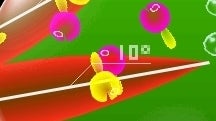Even if Electroplankton wasn’t about various things that live in the water, I suspect that looking down into its depths would still feel a lot like moving between different rockpools, each one its own little universe filled with unique creatures, swarming and multiplying. In 2005, when the game, directed by Toshio Iwai, an interactive media and installation artist, was released in Japan, sound toys were just starting to spark and judder in browsers and Flash players. Something was happening! And yet Electroplankton already felt very different. It wasn’t just sound, it was sound and . As you moved between the scattered electroplankton and worked out what noises they might make, you were also learning what they liked to do, and how they lived.
Some of these creatures I loved immediately. Take Tracy, who opens the game, a little kite-shaped delight who follows the spiked trails you lay down with the stylus, playing as she goes. Is that the piano? Maybe. Tracy is a glissando doodler, speed and precision and the tumbling together of different tracks. I always let all of the Tracies go and then inevitably end up scribbling them together into a little snarl of jangling noise – a bait ball, and we’re back in the oceans.
Lumiloop is another easy favourite – ghostly rubber rings, but somehow we’re in church. Spin these rings and they start to glow, and emit low sonorous tones. It’s not so much music of the spheres as music of a bunch of donuts – donuts with faces – but it’s still transporting, melancholy, otherworldly. I take a breath each time and hold it.
I know other people have loves too: Beatnes has always been a bit of a media star, even if its invitation to sample the familiar beats of Super Mario seems a touch too ingratiating, and jars slightly given the distinctiveness, the separation from the rest of video games, that the other electroplankton represent. Then there’s Volvoice, a regular in my house because my daughter loves to sample bits of chat and play it back at different speeds, different frequencies, blather running forwards and backwards as she prods at the Volvoice outlines.
All these fish are yours, as Clarke almost wrote, but then there’s Hanenbow. Hanenbow the difficult second electroplankton, squished in between the easy charm of Tracy and the Lovelace speedruns on Luminaria, who buzzes endlessly around an arrowed maze of the player’s cruel, panicked devising. Hanenbow seems different from the other electroplankton, less immediate, somehow, more of a puzzle, more of a challenge. But this weekend I sat down with them properly and the whole thing finally came into focus for me. Hanenbow, it turns out, is glorious.
